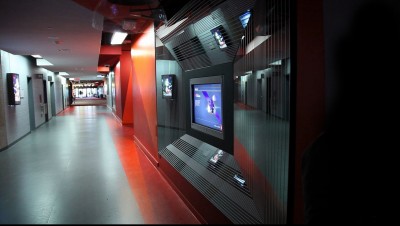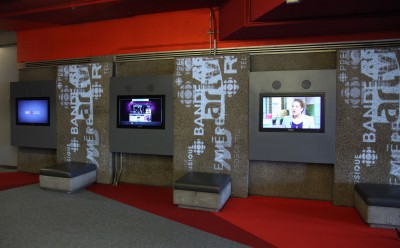Managing content
Radio-Canada required a series of complex digital signage content templates and scripts, web browser integration and a custom interactive audio player. Telecine staff engineered these elements using out-of-the-box Scala software tools, without needing much new coding, while also consulting with the client to steer the project toward the most efficient, cost-effective, easily updated content templates.
“One of their requirements was the ability to manage content without needing special training,” says Fine. “Some of the news feeds, for example, come in from their system automatically.”
“The CBC people find it really easy to use this system and replace information,” says Larry Pieters, Telecine’s project manager. “We’re helping them design that content and use templates they can update.”
This complete, centralized content management system had to manage and update multiple types of display screens, with scalability for future expansion.
“Many people use this software for only a subset of what it can do,” says Fine. “This project used more of those capabilities. The platform lets us do almost anything and we have programmers on staff who do nothing else but work with it.”
Scala’s software was used somewhat similarly in 2010 during the Winter Olympics in Vancouver to support the Bell Ice Cube, an interactive video environment housed in a temporary (3,000-sf) structure. The centre attracted more than 4,000 visitors each day during the games, allowing them to watch teams compete in high-definition (HD) and to interact with Bell’s ‘smart cube’ displays.

Hardware installation was handled by the broadcaster’s own technicians, given their already-extensive experience with display equipment.
Another key factor in this regard for Radio-Canada was the fully bilingual content management interface for the Scala software. This meant in-house system users could operate in their choice of either French or English.
“They’re the largest single producer of French-language media anywhere in the world,” says Fine. “Our bilingualism, too, was an asset, as was our proximity. They’re within bicycling distance from our office.”
Sharing the concourse
The system was deployed within the facility’s 1-km (0.6-mi) long grand indoor concourse, which is accessible to the general public at all times, but by then was already overdue for a modernization effort to reflect the broadcaster’s creativity, current values and heritage.
Before Telecine’s involvement, Montreal-based Sid Lee Architecture had worked with Radio-Canada to design the concourse’s new look, including refreshed décor. As this process sketched out screen locations, it helped Telecine determine later to how to integrate digital signage into the environment, in terms of ambient lighting and sightlines.






